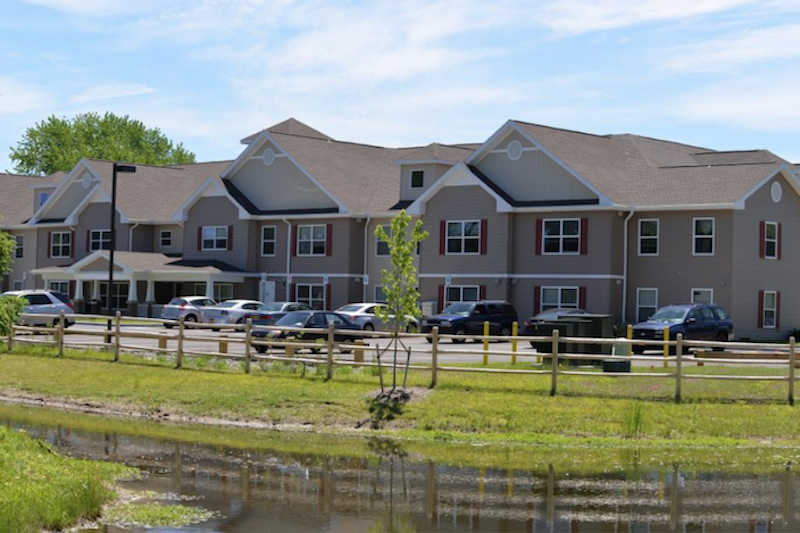Long Pond Senior Housing, a building that combined the New York State Homes and Community Renewal (NYSHCR) 9% tax credit program and the Department of Health’s (DOH) licensed Enriched Housing Program for frail seniors was the first of its kind in New York State.
The project, which achieved LEED Gold certification, was designed to comply with the Governor’s Medicaid Redesign Team (MRT), a program intended to achieve measurable improvement in health outcomes, sustainable cost control, and a more efficient administrative structure. The project reduced wood waste by using panelized off-site construction.
The Rochester, N.Y.-area project averaged a Home Energy Rating System (HERS) Score of 51, roughly a 49% energy reduction compared to a home built to code. High efficiency central hot water boilers, furnaces and air conditioning; advanced air sealing strategies; energy efficient lighting and appliances; and upgraded insulation resulted in high-energy performance.
The building team had to use NYSHCR’s design standards and fit 54 units into 53,000 sf within a per-square-foot budget, and convert 25% of the building’s space into a shared common area, constrained by living and dining space minimums.
Related Stories
| Jul 18, 2014
2014 Giants 300 Report
Building Design+Construction magazine's annual ranking the nation's largest architecture, engineering, and construction firms in the U.S.
| Jul 7, 2014
7 emerging design trends in brick buildings
From wild architectural shapes to unique color blends and pattern arrangements, these projects demonstrate the design possibilities of brick.
| Jul 2, 2014
Emerging trends in commercial flooring
Rectangular tiles, digital graphic applications, the resurgence of terrazzo, and product transparency headline today’s commercial flooring trends.
| Jun 30, 2014
Research finds continued growth of design-build throughout United States
New research findings indicate that for the first time more than half of projects above $10 million are being completed through design-build project delivery.
| Jun 18, 2014
Arup uses 3D printing to fabricate one-of-a-kind structural steel components
The firm's research shows that 3D printing has the potential to reduce costs, cut waste, and slash the carbon footprint of the construction sector.
| Jun 12, 2014
Austrian university develops 'inflatable' concrete dome method
Constructing a concrete dome is a costly process, but this may change soon. A team from the Vienna University of Technology has developed a method that allows concrete domes to form with the use of air and steel cables instead of expensive, timber supporting structures.
| May 29, 2014
7 cost-effective ways to make U.S. infrastructure more resilient
Moving critical elements to higher ground and designing for longer lifespans are just some of the ways cities and governments can make infrastructure more resilient to natural disasters and climate change, writes Richard Cavallaro, President of Skanska USA Civil.
| May 20, 2014
Kinetic Architecture: New book explores innovations in active façades
The book, co-authored by Arup's Russell Fortmeyer, illustrates the various ways architects, consultants, and engineers approach energy and comfort by manipulating air, water, and light through the layers of passive and active building envelope systems.
| May 19, 2014
What can architects learn from nature’s 3.8 billion years of experience?
In a new report, HOK and Biomimicry 3.8 partnered to study how lessons from the temperate broadleaf forest biome, which houses many of the world’s largest population centers, can inform the design of the built environment.
| May 13, 2014
19 industry groups team to promote resilient planning and building materials
The industry associations, with more than 700,000 members generating almost $1 trillion in GDP, have issued a joint statement on resilience, pushing design and building solutions for disaster mitigation.

















